
Geranium is a genus of 422 species of annual, biennial, and perennial plants that are commonly known as geraniums or cranesbills. They are found throughout the temperate regions of the world and the mountains of the tropics, with the greatest diversity in the eastern part of the Mediterranean region.

Alstroemeria, commonly called the Peruvian lily or lily of the Incas, is a genus of flowering plants in the family Alstroemeriaceae. They are all native to South America, although some have become naturalized in the United States, Mexico, Australia, New Zealand, Madeira and the Canary Islands. Almost all of the species are restricted to one of two distinct centers of diversity; one in central Chile, the other in eastern Brazil. Species of Alstroemeria from Chile are winter-growing plants, while those of Brazil are summer growing. All are long-lived perennials except A. graminea, a diminutive annual from the Atacama Desert of Chile.

Oxalis is a large genus of flowering plants in the wood-sorrel family Oxalidaceae, comprising over 550 species. The genus occurs throughout most of the world, except for the polar areas; species diversity is particularly rich in tropical Brazil, Mexico, and South Africa.
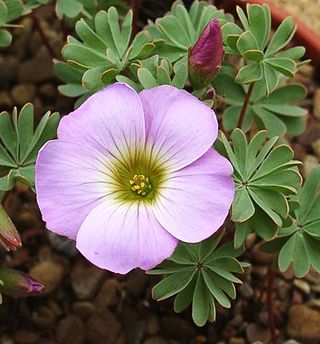
Oxalis enneaphylla, or scurvy grass, is a late spring- and summer-flowering, rhizomatous, alpine perennial herbaceous plant native to the grasslands of Patagonia and the Falkland Islands. It is a small plant that grows to 7 cm (2.8 in) high and 10 cm (3.9 in) across, with slightly fleshy, hairy, blue-grey leaves, which are edible but have a sharp taste due to their high oxalic acid content. The name enneaphylla comes from the Greek εννεα (ennea), "nine" and φυλλον (phyllon), "leaf".
Hardiness of plants describes their ability to survive adverse growing conditions. It is usually limited to discussions of climatic adversity. Thus a plant's ability to tolerate cold, heat, drought, flooding, or wind are typically considered measurements of hardiness. Hardiness of plants is defined by their native extent's geographic location: longitude, latitude and elevation. These attributes are often simplified to a hardiness zone. In temperate latitudes, the term most often describes resistance to cold, or "cold-hardiness", and is generally measured by the lowest temperature a plant can withstand.

Ipomoea lobata, the fire vine, firecracker vine or Spanish flag, is a species of flowering plant in the family Convolvulaceae, native to Mexico and Brazil.
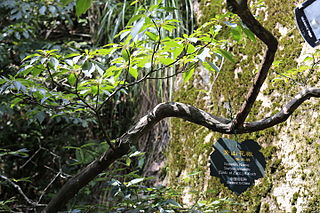
Sorbus commixta, the Japanese rowan, is a species of flowering plant in the family Rosaceae, native to central and eastern China, Korea, Japan, and Sakhalin.

Oxalis triangularis, commonly called false shamrock, is a species of perennial plant in the family Oxalidaceae. It is native to several countries in southern South America. This woodsorrel is typically grown as a houseplant but can be grown outside in USDA climate zones 8a–11, preferably in light shade.
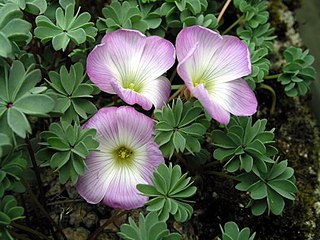
Oxalis adenophylla, commonly known as Chilean oxalis or silver shamrock, is an Argentinian and Chilean alpine plant.
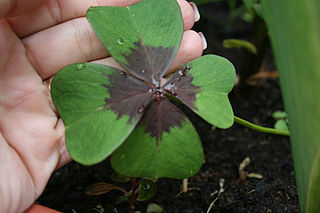
Oxalis tetraphylla is a bulbous herbaceous perennial plant from Mexico. It is sometimes sold as lucky clover or shamrock. In the wild or feral state it is often called four-leaved wood-sorrel after its family, Oxalidaceae. Other English common names for this plant include Lucky Clover, Four-Leaf Sorrel, Four-Leaf Pink-Sorrel and others. It is sometimes called "the iron cross plant" or "oxalis iron cross" because the leaves loosely resemble the iron cross symbol, though this name is not a classic folk term and has fallen out of favour due to the bad political connotations associated with this symbol.

Lewisia brachycalyx is a species of flowering plant in the family Montiaceae, known by the common name short-sepal bitter-root or shortsepal lewisia. It is native to the mountains of the southwestern United States and Baja California, where it grows in moist habitat such as meadows.
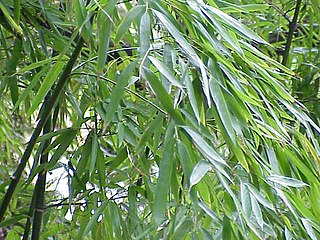
Phyllostachys aurea is a species of bamboo, and is of the 'running bamboo' type, belonging to the diverse Bambuseae tribe. It is native to Fujian and Zhejiang in China. It is commonly known by the names fishpole bamboo, golden bamboo, monk's belly bamboo, and fairyland bamboo (Australia).

Pseudosasa japonica, the arrow bamboo or metake, is a species of flowering plant in the grass family Poaceae, native to Japan and Korea. This vigorous bamboo forms thickets up to 6 m (20 ft) tall with shiny leaves up to 25 cm (9.8 in) long. The culms are typically yellow-brown and it has palm-like leaves. The common name "arrow bamboo" results from the Japanese Samurai using its hard and stiff canes for their arrows. It grows up to 4 cm (1.6 in) a day.
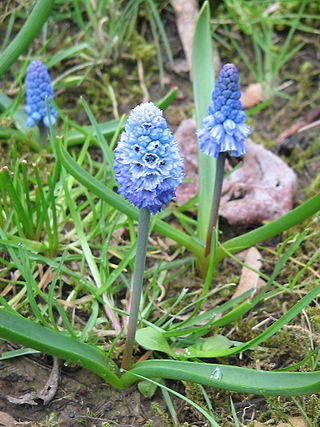
Pseudomuscari azureum, the azure grape hyacinth, is a species of flowering plant in the family Asparagaceae, native to Turkey. A bulbous perennial, it is grown in gardens for its spring flowers. The Latin specific epithet azureum means "bright blue", a reference to its flower colour.
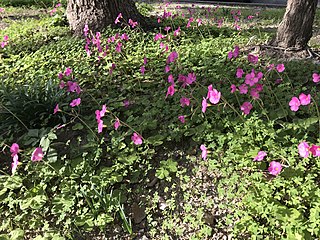
Oxalis articulata, known as pink-sorrel, pink wood sorrel, windowbox wood-sorrel, Chari amilo (Nepal),sourgrass,Netho (khatta) saag (India) is a perennial plant species in the genus Oxalis native to temperate South America. It has been introduced in Europe in gardens and is now naturalized in these areas.

Indocalamus tessellatus, the large-leaved bamboo, is a species of flowering plant in the grass family Poaceae, native to China. A medium-sized, hardy evergreen bamboo growing to 2 m (6.6 ft), it forms a clump of broad leaves 60 cm (24 in) long and up to 10 cm (3.9 in) wide – the broadest of any bamboo – which cause the slender cane to bend under their weight. Though hardy down to −15 °C (5 °F) and able to survive conditions in most of the UK, it prefers a sheltered site in semi-shade with moist, rich soil. Given the best conditions possible, it will eventually form large thickets or groves, but can be kept in a large container. In cultivation in the UK it has gained the Royal Horticultural Society's Award of Garden Merit.

Kniphofia rooperi, Rooper's red-hot poker, is a species of flowering plant in the family Asphodelaceae, native to the Eastern Cape of South Africa. Growing to 1.2 m (3.9 ft) tall, it is a robust evergreen perennial with strap-shaped leaves produced at an angle from the main stem. In autumn the stout central stems bear flattened oval flowerheads consisting of many tubular florets packed closely together. Green in bud, the flowers open to bright red and fade from the base to yellow and brown, thus giving the appearance of a red-hot poker.

Phyllostachys vivax, the Chinese timber bamboo, is a species of flowering plant in the bamboo subfamily of the grass family Poaceae, native to China.

Oxalis massoniana, Masson's wood sorrel, is a species of flowering plant in the family Oxalidaceae, native only to Van Rhyns Pass, South Africa. It has gained the Royal Horticultural Society's Award of Garden Merit.

Oxalis melanosticta, the black-spotted wood sorrel, is a species of flowering plant in the family Oxalidaceae, native to the southwestern Cape Provinces of South Africa. Its cultivar 'Ken Aslet' has gained the Royal Horticultural Society's Award of Garden Merit.



















